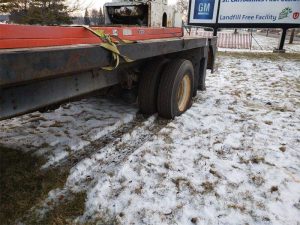
Operators will find as the boom is extended and lowered, the maximum allowed load will greatly decrease. Before lifting any signage, it is important one goes over the max distances for both height and radius to make sure they are operating within the safe zones of the load chart.
Weather can also play a huge factor when lifting a load; one should never operate a boom truck during wind speeds greater than 11 m/s (36 fps). The load charts attached to the equipment are calculated without wind load. When taking wind speed into consideration, it can easily double the weight of the load. Another weather-related consideration is rain as it can not only make things slippery, but can also collect in certain areas of the load. In this regard, a sign installer will need to pay close attention to this as it can increase the weight of the load.
Cold weather installs are another factor in Canada, especially in the western regions where temperatures can drop below -40 C (-40 F). In these frigid temperatures, plastics and metals are very brittle, and hydraulic fluid becomes very thick. As a result, boom trucks are slower to operate and the motors need to work extra hard to pump the oil through the hydraulic systems. Further, cold weather puts a lot of pressure on fittings and hoses, so it is important for operators to make sure they are in good working order and not cracked or damaged. Adding heaters to the truck’s oil pan can help greatly in terms of the motor’s longevity as it will not have to work as hard to pump oil through the lines.
Lightening is another huge factor when it comes to operating a boom truck. In case, one must make sure they are always on top of the current weather conditions. If there is any chance for lightning to occur it is always a safe bet to reschedule the job. The crew’s safety is paramount. In some cases, it is unpredictable when this type of weather may occur; however, should an operator see lightening, they should have an emergency plan in place to vacate the vehicles and get to safe cover where the crew can wait the storm out.
Climate also plays a factor when the truck is going to be parked for the duration of the job—be it snow, rain, or heat. Therefore, a sign installer needs to know how to properly plan for the jobsite based on the forecasted conditions.
Ground safety
A lot of times one will be required to drive on grass, dirt, or soft ground to reach the area where the sign is being installed. In these cases, the operator should test the ground before driving on it. A good way a sign installer or truck operator can do this is by digging one’s heal into the ground to see if it is solid. Another failsafe is to ask the landlord or client if other vehicles have recently driven on the property.

A lot of times one will be required to drive on grass, dirt, or soft ground to reach the area where the sign is being installed. In these cases, the operator should test the ground before driving on it.
If the ground is too soft, or if one is simply unsure, it is a good idea to have a few sheets of 19-mm (0.75-in.) plywood on hand to lie down to create a pathway for the truck to drive on. It is also good practice to park on the plywood when the truck will be idle for most of the day as a way to prevent it from sinking into the ground.
Concrete sidewalks or roadways are not always rated for boom trucks to drive on. If one has to drive on a concrete access point to reach a jobsite, it is important to know the rating of the concrete. If a concrete access point is mainly intended for foot traffic it is likely it was not designed to provide passage for boom trucks. Driving onto this type of concrete could potentially crack or damage the pathway. Should this occur, it will result in costly charges being billed back to the sign company. Therefore, asking the right questions beforehand will help alleviate any unnecessary stress.
Mark Wallis is one of the owners of Signature Sign & Image in Niagara Falls, Ont. He is also the director of safety and installations for the Young Professionals Network (YPN). Wallis can be contacted via email at mark@signaturesigns.ca. For more information on the YPN, follow the group on Instagram @ypncanada.





